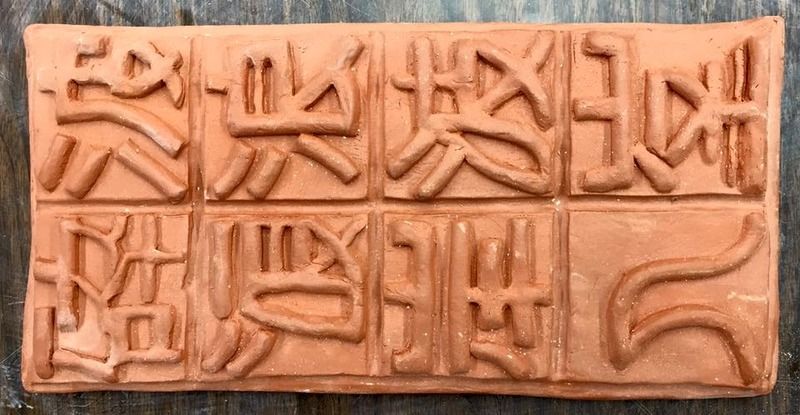A friend of mine recently found this in his stockpile of art, and he’s curious as to what the characters on it might say (I’ve been told they’re ‘tilted left’, but the source for that doesn’t know the translation of the characters). Can anyone here lend me a hand?
Yes, the image is rotated 90 degrees to the left. You might get quicker responses if you were able to correctly rotate to the right and re-post.
My exposure to Chinese characters is through Japanese, which uses many of them with approximately the same meaning per character, but probably not the same meanings in combinations like this. Also, many of these appear to be possibly archaic formations that would have modernized forms, and I can’t find them as given in my large kanji dictionary.
However, the first one in the upper left (would be upper right if rotated) is given the meaning of “drawing water” which I guess makes it a verb. The next one also has the radical for water but a different meaning. The last and simplest one might be “person” but it is drawn very oddly if so.
Sorry, that’s the best I can come up with. Someone more knowledgeable should be along shortly.
This should be the correct orientation: http://i.imgur.com/YTRcJFZ.jpg
Thank you for the re-alignment. Hopefully that’ll help!
The characters are read right side first from the top.
Upper right side, the first two characters together mean “wave”.
Last two also can also mean “waves”
First character (left) means “pieces” or “broken parts”.
Second looks like it might have been “written” wrong, but appears that it might be another character for “wave”.
Third means “coastline” or “river bank”. Anywhere were water meets land.
Fourth means “a few”.
Overall meaning? A guess might be that even a few waves break up and erode the land eventually.
(Translated by Taiwanese wife.)
I think that bottom character on the left is a literal picture of a wave.
To me, they look like they were produced by someone who might be acquainted with such characters but not a fanatic about how they are written, if you catch my drift. (waves, drift, get it?!?! never mind.)
I think it was someone using the characters as art rather than words, kind of playing with the characters.
If they were intended to be Japanese and produced by someone modern,
then you might order them
1 2
3 4
5 6
7 8
1 and 2 together can be read “saiha” which means “crashing waves”
3 and 4 can be read as “roro” which while repeating a character for wave actually means “wandering” or “unemployed” if the Internet is to be believed. (And these are both the same character, yet look at how different they look…that’s what I mean about someone who is not a fanatic about how they are written). For example, this is the character used in the word “ronin” -> drifter, wanderer, masterless samurai, student who failed the exams to get into a college.
5 and 6 would be read as Kishinami, which is a Japanese name (it doesn’t seem to be a word as such) but refers to “coast” and “wave”. Characters 2 and 6 are also the same character, even though they look different. Again, not someone precise about how the characters are written.
7 appears to be a picture of a wave, rather than a character. Since that would not actually be a character, this is why I think this whole piece is someone playing with the characters as decorative or artistic elements more than writing a literal meaning.
8, best as I can tell, looks like a variant of the character “mine” (a Japanese word pronounced “me-neigh”; in the standard character, the top portion is written on the left side) which means “mountain top” or “ridge of a mountain”. How that fits in with waves, I don’t know. Maybe the artist thought his picture of a wave looked like a mountain peak, too, or maybe felt that a mountain peak is the opposite of a wave, or a wave is a mountain peak on an ocean.
Just my guesses.
After a couple of decades of reading mangled English created by Japanese or Chinese tee-shirt designers, it’s nice to see it go the other way.
Obviously a non-native wrote this, because the third character down on the right side (when oriented correctly) is incorrect. It’s the same character as the upper right and a stroke is missing.
It has no meaning either in Japanese or Chinese, but is a bunch of words or characters put together because the artist likes them.
I agree that the bottom left picture is likely a stylized picture rather than a character.
